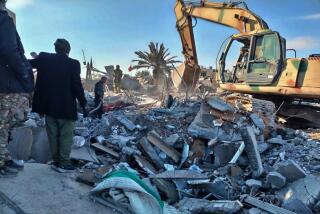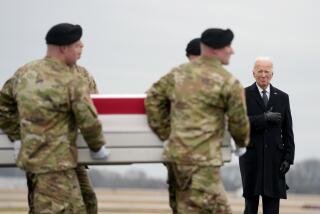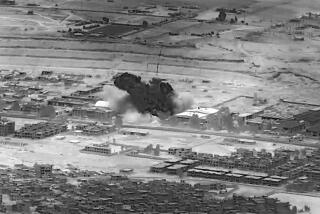U.S. Military Strategy Will Shift Soon, Officials Say
WASHINGTON — Until now, the air attack against Afghanistan’s Taliban regime has closely resembled U.S. military campaigns in Kosovo and Iraq. What comes next, Pentagon officials say, won’t be in the standard playbook.
Special operations forces will seek to hunt down leaders of the Al Qaeda terrorist network in the Afghan mountains and desert. They will rely on intelligence reports from various sources in an attempt to find terrorist leaders, and then they will shoot to kill, high-ranking defense officials said in interviews.
Light infantry forces will be ordered to secure Afghan airfields from which U.S. aircraft could operate. Those troops also may guard borders, such as Uzbekistan’s, that could come under Taliban attack in reprisal for support of the U.S.-led campaign. The troops will also be on standby, ready to swoop in and help U.S. commando teams that get into trouble.
The mission to secure the country could take as long as a year, officials said.
With the large-scale air bombardment expected to all but stop by the end of this week, U.S. aircraft will be used with some regularity to strike Taliban forces on the ground in the coming days and weeks. But the hard work will shift to commandos and ground troops deployed for missions in which the elements of surprise and maneuverability will be more important than technological superiority.
“It’s a different kind of conflict,” Air Force Gen. Richard B. Myers, chairman of the Joint Chiefs of Staff, said Tuesday.
Special commando teams from the Army and Air Force, trained to drop quietly behind enemy lines and trained in sabotage, kidnapping, sniper skills and guerrilla warfare, have begun infiltrating Afghanistan, according to Pentagon officials who asked not to be identified because of administration policy of not discussing current operations.
Now, amid reports that the airstrikes and missile strikes are beginning to flush terrorists and Al Qaeda-linked Taliban military units out of their hiding places, the commandos will be in position to strike, the officials said.
“What we’ve seen here in the initial phase is similar to Iraq or Kosovo, except that it’s not as rich a target environment,” said Michele Flournoy, a former Pentagon military strategist. “But what’s different is what comes next.”
The Pentagon’s strategy is designed to give the United States maximum flexibility to adapt to conditions on the ground in Afghanistan, defense officials said. And while the U.S. military is planning to strike against terrorist hide-outs and facilities in other countries that harbor terrorists, strikes elsewhere are unlikely to begin before the situation in Afghanistan is well under control.
In the next week, 1,000 more soldiers from the Army’s 10th Mountain Division will join the 1,000 already in Central Asia, defense officials said.
A large naval force, including at least two full carrier battle groups, will remain in the region. In addition, the Kitty Hawk aircraft carrier will serve as a mobile base for special operations teams or light infantry. Army helicopters deployed to the carrier--which recently left Japan without most of its usual complement of aircraft--will carry Special Forces troops and equipment into Afghanistan, perhaps stopping at an air base in Pakistan.
If Osama bin Laden, believed to be the architect of the Sept. 11 attacks on New York and the Pentagon, starts rebuilding the infrastructure of his terrorist network, or if the Taliban tries to reconstruct its airfields, U.S. bombers will strike again. If the extremist regime starts concentrating its troops, “we’ll go hit them hard,” one defense official said.
But U.S. air power won’t be used in a constant close air support role, one defense official said. In the Pentagon’s view, that isn’t necessary, because Taliban forces simply aren’t that numerous and they don’t have major assets--such as large numbers of tanks or artillery--to hit.
The air support role will be more like the relationship that NATO had with the separatist Kosovo Liberation Army in 1999, the defense official said. In the U.S. campaign to end a brutal Serbian crackdown on the ethnic Albanian province, the rebels would notify NATO forces when the Serbs had concentrated armor or troops, and the NATO forces would launch airstrikes against them.
“Coming up now, and tomorrow, and whenever . . . we will be gathering additional intelligence from the ground and through various intelligence assets that will enable us to seize targets of opportunity,” Defense Secretary Donald H. Rumsfeld said Tuesday. “And that means you have to wait until they emerge.”
The job of gathering intelligence will be key. Although technical means such as satellite pictures and eavesdropping may be important, the U.S. forces are likely to get more help from other countries’ intelligence agencies and local informants.
But even with assistance from these sources, past experience has shown some of the intelligence will prove unreliable. And getting it right takes time and luck.
One issue that defense officials haven’t resolved is whether to hit certain infrastructure targets, such as roads, tunnels and bridges, that could hamper the Taliban.
One defense official said he doubts the United States would want to strike at such assets, because that might be viewed as punishing the Afghan people. Such strikes would hamper relief efforts and force the United States to pay more for the rebuilding of the country, which the Bush administration has stressed is a key goal.
A priority of U.S. forces will be to prevent the Taliban regime from pressing its attacks against rivals within the country such as the Northern Alliance.
In the northern city of Mazar-i-Sharif, and along two mountainous fronts north of the Afghan capital, Kabul, Taliban forces and fighters recruited by Bin Laden from throughout the Arab world have been facing off against the Northern Alliance.
Commanders of the rebel force complain that they haven’t seen evidence of strikes along the front. But the Pentagon says the United States has been bombarding some Taliban positions there, including a barracks.
More to Read
Sign up for Essential California
The most important California stories and recommendations in your inbox every morning.
You may occasionally receive promotional content from the Los Angeles Times.











